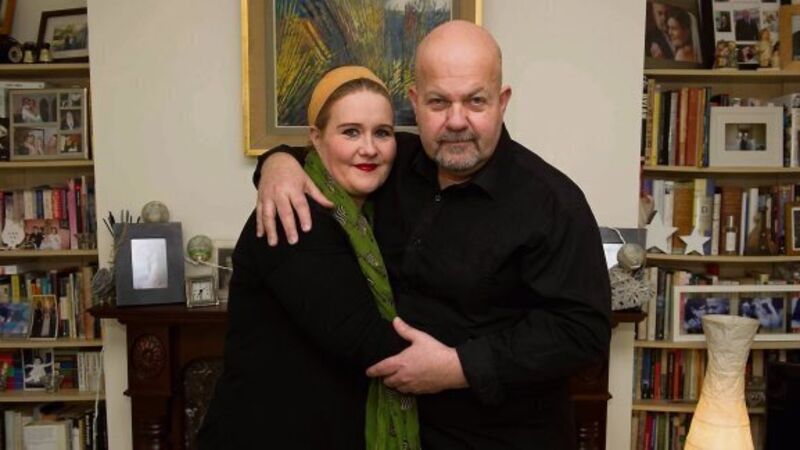June Shannon’s rocky road to motherhood

SIXTEEN weeks into a pregnancy that traverses half of Europe and took three to tango instead of two, June Shannon is finally on the cusp of motherhood.
The 43-year-old, who has spoken on the national airwaves about her difficulties conceiving, opted for egg donation after six years of mostly heartbreak, much expense and multiple disappointments travelling the more traditional IVF route.
The Cork woman, now living in Dalkey, Co Dublin, did not arrive at the decision lightly. Herself and husband Tony Curtis weighted up the pros and cons ad infinitum and teased out the possibility for a year or more.
READ MORE: ‘IVF can be a bit of an emotional rollercoaster’ .
“We had to decide if we would be happy with the fact that it wouldn’t be my biological child,” June says.
In fact the hardest part of the entire process once they made the decision was the day she had to sign the egg donation consent form. “I was overcome with grief that I would never have a child of my own.
“Signing that form meant I was drawing a line under the possibility of ever having my own biological child.”
Still, the urge to be a mother carried her through.
Tony (56) and June wed in December 2006 and tried conceiving naturally for a couple of years. A family featured strongly on their wish list but pregnancy eluded them. By 2009, June aged 38, they decided to try IVF, a demanding process both physically and mentally.
“It’s just the most intense experience,” she says. “You’re constantly being scanned to see if you’re responding to the meds and you’re wondering if they will try to collect any eggs, and if they do, will any of them fertilise, and then if any of them will survive.”
When the time was right, eggs were harvested while June was under sedation and mixed with her husband’s sperm in a lab for the purpose of fertilisation. The resultant embryos were then cultured in a lab for a few days followed by transfer of the healthiest to June’s uterus. “You have to wait two weeks after the transfer to do a pregnancy test. It was the longest two weeks of my life,” says June..
She was ecstatic when the test was positive and utterly crushed when she miscarried at nine weeks. “That threw me,” she says quietly. “It took a few months to get over that.”

When her head was ready, two more treatment cycles followed using frozen embryos, generated in the previous treatment cycle. Two embryos were transferred in the first “frozen” attempt. Neither took. Nor did the embryo in the third treatment cycle. Towards the end of 2012, they opted for another “fresh” treatment cycle. This was perhaps the cruellest time. June’s beloved mother, Clodagh passed away on the week of that last fresh cycle. As they were trying to cope with the grief and prepare for a visit to the clinic, they got a phonecall to say the embryos hadn’t survived the night.
“I took a year out to recover. I needed to be able to grieve for mum. And we needed time to think about the donor option and see if we could get our heads around it,” June says.
After reflecting long and hard and with all other options exhausted, Tony and June resolved to go ahead. If they have a daughter, they will call her Clodagh, after the grandmother she never met, but whose generosity funded her existence. If it’s a boy, he will answer to the name of Jack, in keeping with a tradition either side of the family.
“I have Clodagh and Jack in my head for six years,” June says. She can’t wait to use one or the other.
Two women have June’s lifelong gratitude for the pregnancy that is now in its second trimester. The first is her cherished mother.
“This process would never have been possible but for the money my mother left me when she died. She is basically helping us from the grave. Without her help, we wouldn’t have been able to go ahead. She knew this was all I ever wanted,” June says.
The second woman is the anonymous 21-year-old living in the Czech Republic who donated her eggs.
DISCOVER MORE CONTENT LIKE THIS
“I can’t tell you how grateful I am to the donor,” June says, “Without her I would never get the chance to be a mum.”
What makes June sad and angry is that the prohibitive costs of fertility treatment deny many of the one in six couples affected by infertility the opportunity to ever be a mum or dad.
June, a journalist, and Tony, a graphic designer, have spent the bones of €21,000 since 2005, which includes €9,000 on the donor treatment. IVF treatment cycles cost in the region of €4,000-€5,000 each.
There is limited cover available under private health insurance. There is very little available for public patients. The Human Assisted Reproduction Unit (HARI) in Dublin’s Rotunda, where patients have to be referred from the hospital’s outpatient department, is an option for some medical card holders.
Even then, there are certain criteria to be met — the woman must be under 40, both members of the couple must have medical cards, both must be non-smokers and have no other children.
Funding from the State towards IVF extends to medication only and not the IVF process itself. Medical card holders have their medication paid for. Those without a medical card who spend more than €144 a month on drugs can claim back under the Drug Payment Scheme.
The only other assistance from the State is that those who pay for the treatment themselves can claim a 20% tax rebate.
“When I think about the lack of public funding and what that means when people can’t afford to pay, it really upsets me. It’s just not right. The World Health Organisation (WHO) defines infertility as a disease, so why can’t the State assist people?” June asks.
At any rate June’s mother’s bequest got her over this hurdle, along with the help of Dalkey Credit Union. She chose a Dublin clinic for the donor treatment, one that doesn’t require the recipient to travel abroad for embryo transfer. It was a different clinic to the one she had previously used. Her husband’s sperm was sent to an affiliated clinic in the Czech Republic where it was mixed with the donor’s eggs.
The resultant embryos (three) were flown back to Ireland.
June had been taking drugs to build up the lining of her womb in preparation for the embryo transfer. She had to continue taking hormone tablets until week 12 of her pregnancy.
However she describes the process as “less invasive” than traditional IVF because her ovaries did not have to be stimulated, nor did she have to go under anaesthetic.
I ask her if the transfer process itself — where the embryos are placed in the neck of the womb using a small plastic tube — was daunting?
“You just do whatever you have to do,” she says, driven by the ultimate goal of a baby to cradle. She doesn’t have a birth plan, it’s early days yet she says, but she’ll do whatever is required, caesarian or otherwise. “To be honest all we want is a healthy baby so if that requires a C-section, that’s fine with me.”
As the baby’s biological father, there’s a good chance it will share some of Tony’s physical characteristics, but there’s also a chance it will share some of June’s because the clinics always try to match the donor as closely as possible with the woman.
The embryo transfer took place on December 18. Two were transferred and one took.
A positive pregnancy test two weeks later got the New Year off to a terrific start. Their first scan at six weeks was overwhelming. “We saw the heartbeat. Tony cried. It was really, really amazing,” June says.
Now, every scan is wonderful, she says. Their families are over the moon.
“Tony’s parents are beside themselves, he’s an only child and this will be their first grandchild.” June is trying not to get too swept up in the excitement. She’s had so many disappointments, she’s unlikely to really relax until the baby is born.
She plans to tell her child about the journey they embarked on to create her, using age-appropriate information along the way. Implications counselling, mandatory for all couples wishing to avail of egg donation, helped them tease out some of the issues they had not considered before.
June believes if a child grows up knowing where they came from, it avoids a lot of potential pitfalls later on. The name of the donor will never be known however, because she chose to donate anonymously.
What the baby will know is that she is “loved beyond belief” June says, as she looks forward to her world changing forever come September 4 next.
DISCOVER MORE CONTENT LIKE THIS










